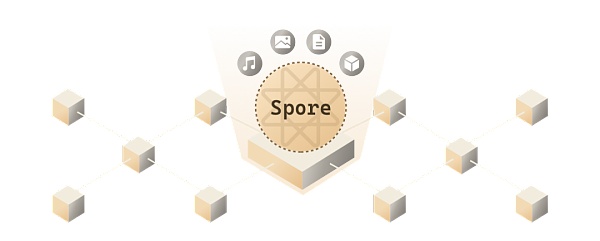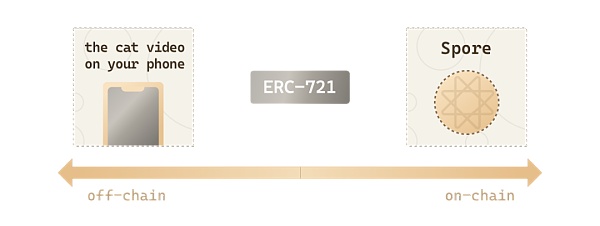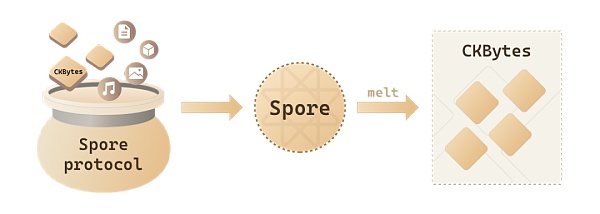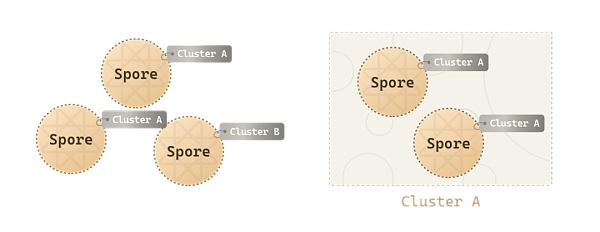Source: ByteDance CKB
Last Friday, JoyID Wallet officially released the first Spore DOB Marketplace, and has opened trading for the first DOB asset - Unicorn Box.
DOB (Digital Object, Digital Object) is a crypto asset issued through Spore, the digital object creation protocol on the CKB blockchain. The Spore protocol is not exactly the NFT protocol that many people are familiar with, because the DOB generated by the Spore protocol is not only tamper-proof and completely stored on the chain, but also establishes an inherent connection between content and value. Specifically, generating DOB requires obtaining CKB tokens as "raw materials". The amount of CKB minted determines the size of the DOB's on-chain storage space, and destroying DOB can retrieve the occupied CKB. This mechanism ensures that holding Spore DOB is equivalent to occupying CKB, thereby reducing the circulation of CKB within the ecosystem, which will have a positive impact on the secondary market of CKB - as more CKB is occupied, their value is expected to increase . This establishes a healthy symbiotic relationship between the creators and holders of Spore DOB, and the CKB ecosystem as a whole.
In today’s article, we will introduce in detail the digital object creation protocol Spore on the CKB blockchain and its many innovations.
The Origin of the Spore Protocol
According to the team, the Spore protocol was conceived a year ago and was largely inspired by Ordinals. Since Bitcoin does not support smart contracts, there are many things that Ordinals cannot do. From a technical perspective, Ordinals is a very simple protocol, but many people are interested in it and many people are using it. Therefore, the Spore team thought about how to extend the Ordinals protocol from the perspective of CKB, and the Spore protocol came into being.
The Spore team believes that if Bitcoin supports smart contracts, Ordinals should become like Spore. In other words,If you think of CKB as an upgraded version of Bitcoin, then Spore is an upgraded version of Ordinals.
Features of the Spore protocol
1. Supports multiple content types and provides more space for creativity
Different from many small pictures in the Ethereum ecosystem NFT, Spore protocol is not limited to static images or offline links, but also supports multiple content types such as video, audio, text, etc., giving creators more room for creativity.

2. Content All on the chain, allowing users to truly control ownership
NFTs based on the Ethereum ERC-721 protocol, such as CryptoPunks, only store imageHash in their smart contracts, while the images are stored in the center In the server of the larvalabs.com website, if the server hangs up, these pictures will be gone; another example is Boring Ape (BAYC), which stores an IPFS address in its smart contract, so those The pictures of Bored Ape are actually hosted in IPFS. In other words, the contents of most well-known Ethereum NFTs are stored outside the chain, and only one link is stored on the chain. In contrast, DOB minted via the Spore protocol has its content data stored entirely on the CKB blockchain (in the Cell).

If you look at it from a technical point of view, the NFT of the Ethereum ERC-721 protocol, Its actual owner is a smart contract, which specifies which addresses own which NFTs and gives these addresses operating permissions; the DOB minted through the Spore protocol is essentially a Cell (an improved version of UTXO), which is portable , completely controlled by the user, because the Cell can only be unlocked by the user with the private key, and smart contracts cannot control these Cells. This is why there is a problem with the smart contract of Ethereum NFT, and all NFTs may be rug; on the CKB blockchain or UTXO model blockchain, only the leakage of the user's private key may lead to asset losses. This difference is actually caused by the difference between the account model and the UTXO model.
3. Every DOB has CKB as value support
In the CKB blockchain Storing any type of things on the chain requires occupying CKB. One CKB token is equal to one byte of space on the chain. Therefore, if you want to make a 200-byte Spore DOB, you need to purchase 200 CKB to occupy the space on the chain.
This is very interesting, because the blockchain was originally an infinite virtual space, but now it creates a limited resource, and the Spore protocol further amplifies this. Each CKB consumes a lot of power resources and computing power from miners. We use CKB to cast Spore DOB, which is like using gold extracted from ore to create jewelry. Since the raw material gold itself has value, this jewelry Regardless of its level of craftsmanship, there is value. The underlying value of Spore DOB comes from the CKB it occupies, and the value of CKB comes from the entire blockchain network.
The value of gold jewelry is naturally higher than the value of raw material gold, so the value of Spore DOB will naturally be higher than the value of the CKB it occupies. If we don’t like this gold jewelry anymore, we can destroy the jewelry to get back the raw gold. Similarly, if you don’t want this DOB anymore, you can destroy it and get back the occupied CKB.

This mechanism ensures that holding Spore DOB is equivalent to occupying CKB, thus reducing The circulation of CKB within the ecosystem will have a positive impact on the secondary market of CKB - as more Spore DOB are created and held, more CKB will be occupied, and the circulation of CKB will further decrease. , the reduction in circulation will drive up its price, thereby promoting the rise in the value of Spore DOB that uses CKB as the "raw material". The wealth effect brought about by the appreciation of DOB will attract more people to cast and hold DOB, and ultimately Let CKB realize a forward flywheel.
4. No transaction fees, bringing better user experience and privacy protection
Via Spore DOB minted by the protocol will be deposited with 1 more CKB by default during minting, so that you do not need to pay additional gas fees (mining fees) every time you trade DOB in the future. Because when the network is not congested, 1 CKB can pay the miner fees required for more than 7,000 on-chain transfers.
Free transaction fees can bring a better user experience and also mean it is easier to get out of the circle. Just imagine, if you want to give a CryptoPunks to a friend outside the circle, he needs to first learn how to register an Ethereum wallet and learn to save the mnemonic phrase and private key before he can give you the wallet address. After receiving the CryptoPunks, if he If he wants to transfer it to others, he has to go to the market to buy ETH and mention his wallet to transfer out CryptoPunks. During the transfer process, he also needs to learn what gas fee is and how to set gas fee. If it is Spore DOB, you can directly ask this friend outside the circle to open joy.id in the mobile browser, press the fingerprint twice according to the instructions, and create a JoyID wallet in a few seconds. After receiving the Spore DOB, if If he wants to transfer it to someone else, he does not need to purchase CKB as a mining fee. He does not even need to understand what the mining fee means. He can directly enter the other party's address and press his fingerprint twice to transfer out, which is very convenient.
Free transaction fees and better privacy protection. The UTXO model focuses on privacy by default, and the wallet of the UTXO chain will automatically change addresses every time it is used; in contrast, the wallet of the account model blockchain (such as MetaMask) will not actively change addresses for you.
Blockchain data is public and can be seen by everyone. If you always use the same address and all operations are associated with an address, then everyone can analyze your behavior. Vitalik once wrote an article about implementing Stealth Address on Ethereum. When user A transfers money to user B, the blockchain temporarily generates a one-time stealth address. User A transfers the assets to this stealth address. User B can operate the assets at this address. Only the two parties to the transaction know who it belongs to. , others cannot know the real owner of the address through on-chain data. Although stealth addresses can be implemented on Ethereum, the UTXO blockchain has already had similar functions, so stealth addresses are not an innovation in Ethereum.
In addition, the Ethereum stealth address solution is not perfect. Imagine that user A sends an NFT to user B's stealth address 1, and user C sends an NFT to user B's stealth address 2. If user B wants to give these 2 NFTs to his friends, and these 2 There is no ETH on the stealth address to pay the gas fee, so he can only transfer ETH to these two stealth addresses, but in doing so he will expose himself. Or he can also let others pay the gas fee through various complicated agreements, but this will become very complicated. Therefore, the Ethereum stealth address solution is not perfect.
This can be done perfectly on CKB. Some CKB wallets (such as Neuron) will automatically create multiple addresses and automatically change addresses each time they are used. If user A owns 100 Spore DOBs, each DOB can be stored separately at a different address. When transferring, because Spore DOB comes with its own handling fee, so User A can transfer these 100 DOB to other people very conveniently.
5. The contract cannot be upgraded to ensure that DOB remains unchanged
Based on the Ethereum ERC-721 protocol NFT contracts are often upgradeable, which makes it easier to upgrade the contract through multi-signing or other methods when there are bugs in the contract or if you want to add new features.
In contrast, the contract of the Spore protocol that has been deployed on the CKB mainnet is not upgradeable. If this contract has a bug, the contract developer has nothing to do. If there is a bug, there is a bug. That is its flaw, and that is part of this version of it. If we call the deployed Spore protocol version v1.0, if we want to add more features, we can only deploy another new contract instead of upgrading Spore v1.0. This means that there will be many different versions of Spore DOB in the future, some cast through Spore v1.0, some cast through v2.0... DOBs cast with v1.0 will not suddenly become available one day. Upgrade to v2.0 DOB or add some new features you don't like or remove the design you like.
Through this design, Spore DOB becomes an eternal thing in the digital world of CKB. All its content data is on the chain. As long as the CKB chain is running, this DOB will always exist. In addition, since the Spore contract cannot be upgraded, you don’t have to worry about the DOB you hold changing. If it is a DOB minted through the Spore v1.0 contract, it will always be the v1.0 version and will not change. In the real world, jewelry made by one process will not change into what it looks like because of a new casting process one day. That’s why there are antiques in the real world. . Therefore, we can think of Spore DOB as a simulation of the real world.
6. Code reuse without fear of deletion, which greatly facilitates developers
On Ethereum To issue NFT, you need to redeploy the NFT contract, because Ethereum's smart contract contains logic and state, and the two cannot be separated. Logic is equivalent to rules, which stipulate how NFT can be traded and transferred, and what functions it can have; while the status records which addresses own which NFTs.
The logic and state of Spore DOB on CKB are separated, which means that when issuing NFT, there is no need to redeploy the Spore protocol, and you can directly reference this protocol standard. Specifically, Cell is a referenceable storage unit, and CKB is similar to a shared library of code and data for use by smart contracts running on it, so it is easy to reuse code on CKB. This not only saves time and does not require developers to deploy the same code again and again, but also saves space on the chain and reduces deployment costs.
Code reuse does not need to worry about someone modifying the code stored in the dependent Cell, because the Cell is immutable, that is, no one can modify it. Even if the owner of this Cell directly deletes it from CKB, no one will suffer any loss. Anyone who saves a copy of the code (such as those running full nodes or complex light clients) can deploy the same code again on the chain, the reference to the code hash will still be valid, we just use the new dependency Cell to construct the transaction i.e. Can. .
7. Support Cluster, improving transaction efficiency
The Spore protocol also proposes the concept of Cluster, that is, Package multiple DOBs into a set and directly transfer and trade this set to improve efficiency.

8. Support Contract plug-in, with better scalability
The Spore protocol has good scalability, and it can support plug-ins written by other developers for this contract. When calling the Spore contract, the script parameter can specify which plug-ins of the Spore contract to use, and then use these plug-ins to empower DOB to enable DOB to implement more functions.
Of course, if the Spore protocol and its plug-ins cannot achieve the functions that developers want, developers will need to rewrite a DOB casting protocol and deploy it. CKB is a very flexible blockchain that can implement a variety of protocols and standards.
9. Can flow freely between different UTXO chains
According to the current plan, Bitcoin The first-layer asset issuance protocol RGB++ will be launched at the end of March. At that time, DOBs issued on the CKB blockchain can be transferred to the Bitcoin main network through RGB++ Leap and become digital objects on the Bitcoin chain.
In addition to Bitcoin, through isomorphic binding technology and Leap operations, DOB issued on CKB can also become digital objects on other UTXO chains in the future.
More ways to play with the Spore protocol
< p>The Cluster concept mentioned above can help the Spore protocol achieve more gameplay. For example, for a mascot DOB, you can design glasses, earrings, necklaces and other jewelry DOBs for it. These jewelry DOBs and the mascot DOB form a cluster for trading and competition. In other words,
Spore DOB is like Lego bricks, we can use different Lego bricks to form different puzzles, and this can fully mobilize the creativity and imagination of the holder. In addition, we can also innovate in the storage content of Spore DOB. Just imagine, if we want to issue an avatar-type DOB, in addition to the conventional operation of directly storing pictures on the chain, we can also innovatively store only keywords with avatar characteristics on the chain, such as Short hair, dark eyes, high nose bridge, big mouth, white skin, male, and then use a decoder on or off the chain to decode. This decoder is equivalent to a painter who draws an avatar based on these keywords.
The interesting thing here is that the keywords written to the chain remain unchanged, but the decoder can change or evolve. Because of the same keywords, the avatars drawn using different AI models will definitely be different, and the avatars drawn using different versions of the same AI model will also be different. This means that this DOB has the ability to change and evolve, which is very interesting.
Spore is a very flexible and scalable digital object creation protocol. I believe that through everyone’s brainstorming, we can achieve more innovative gameplay.
Write at the end
CKB Chief Architect Jan Xie once said: "When I originally designed CKB, I actually wanted to build a digital world or universe. The world or universe is composed of two dimensions: time and space, andPoW is essentially a Decentralized clock(For specific discussion, please refer to Gregory Trubetskoy’s article), it is a technology that can create time in numbers.UTXO, or CKB’s Cell, is the space on the chain. It stores data. Combining PoW and Cell, we can get a decentralized universe. In this universe, everything we do is actuallyto map our The real world."
In this "real virtual world" built by the CKB blockchain, Spore DOB is an on-chain digital object, which is very much like an object in the real world: it The production of it requires the use of raw material CKB, which can be destroyed and retrieved when it is no longer needed; it has versions, which can remain unchanged like antiques, and can also innovatively possess the ability to change or evolve. The flexibility and scalability of the underlying Spore protocol provide DOB with more possibilities.
 JinseFinance
JinseFinance
 JinseFinance
JinseFinance JinseFinance
JinseFinance JinseFinance
JinseFinance JinseFinance
JinseFinance dailyhodl
dailyhodl Beincrypto
Beincrypto Cointelegraph
Cointelegraph Cointelegraph
Cointelegraph Nulltx
Nulltx Cointelegraph
Cointelegraph